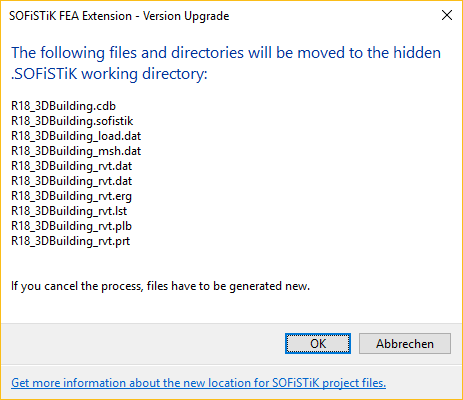Upgrade from Previous Versions#
For projects generated with a previous SOFiSTiK major release, the data will be updated. In such case please check the model and its mappings after upgrade. After upgrading, projects cannot be opened with a previous major release anymore.
2024#
Revit shared parameter
SOFiSTiK_Namehas been extended to new categories: Levels, Grids, Analytical Nodes.Revit shared parameter
SOFiSTiK_Numberhas been introduced. It allows to set the number of the corresponding SOFiSTiK element also from the Revit properties of an instance. As a consequence the values provided under the build-in parameter Node Number for analytical nodes will be copied intoSOFiSTiK_Numberat upgrade. After upgrade, the Number available in the SOFiSTiK Properties Panel exclusively synchronizes with the Revit shared parameterSOFiSTiK_Number.Revit shared parameter for marking level
SOFiSTiK_Levelhas been deprecated. Values set inSOFiSTiK_Levelare now stored in the SOFiSTiK Structural Properties of the level instance resp. in the shared parameterSOFiSTiK_Name.SOFiSTiK_Levelis removed from existing projects during the upgrade to version 2024. Its values are automatically migrated to the correct new parameters.
2023#
Upgrade to the new analytical model#
Starting with Revit 2023, a new analytical model is introduced.
Please refer to Autodesk Revit’s Online Help to learn more regarding what happens when a model is upgraded to the new analytical model.
Additionally, the following changes to the analytical model are specific and/or directly related to SOFiSTiK Analysis + Design workflows:
Analytical columns, analytical beams and analytical braces are upgraded into analytical members. For those elements:
interpolating between a start and an end cross section is maintained. However, starting with Revit 2023, the geometries are read directly from the Family Type set under property Section Type. An example of tapered beam Family Types is available under the Family Content Folder.
cross sections are now generated centric (i.e. having their origin placed at their centre of gravity).
eccentricity is not migrated. New eccentricities can be defined by adjusting the cross section associated to the member.
Analytical floors and analytical walls are upgraded into analytical panels. For those elements:
the previous SOFiSTiK Structural Property Thickness is user defined is obsolete and has been removed.
the value Automatic of SOFiSTiK Structural Property Placement is obsolete and has been removed. At upgrade elements assigned this value will upgrade to the value Centered.
Analytical links, boundary conditions and loads are re-generated by Revit at upgrade, changing their visibility in some views. Please control the visibility of those elements in existing subsystem views and, if necessary adjust it.
For most analytical categories, Revit does not provide a Number property anymore. SOFiSTiK Structural Properties Member Number and Surface Number are maintained but may get lost at upgrade. Therefore they should be controlled and, if necessary, assigned anew.
For most analytical categories, Revit does not provide Phasing properties anymore. Therefore SOFiSTiK Analysis + Design build-in calculation options linked to Construction Stages have been discontinued.
Analytical elements created using the Model In-Place Method are deleted by Revit at upgrade and should be re-modelled.
Previously, the SOFiSTiK elements generated from Revit had, as reference, the GUID of the Revit physical instance they represented. Starting with Revit 2023, the SOFiSTiK elements generated from Revit have, as reference, the GUID of the Revit analytical instance they represent.
Elements ignored after upgrade#
Starting with Revit 2023, the analytical model is autonomous. As a consequence, the categories listed in the table below, which were supported in previous versions of SOFiSTiK Analysis + Design are now ignored. Refer to the Supported Elements and Mapping page for more information on how Revit elements are now supported.
Revit Elements |
Notes |
|---|---|
Floors |
Floors are not supported but if they have a valid analytical counterpart (eg. an analytical panel), the counterpart instance is supported. |
Model In-Place |
Models In-Place are ignored. |
Structural Beam Systems |
Structural beam systems are not supported but if they have a valid analytical counterpart (eg. an analytical member), the counterpart instance is supported. |
Structural Columns |
Structural columns are not supported but if they have a valid analytical counterpart (eg. an analytical member), the counterpart instance is supported. |
Structural Foundations |
Foundation elements are ignored. |
Structural Framing |
Structural framings are not supported but if they have a valid analytical counterpart (eg. an analytical member), the counterpart instance is supported. |
Structural Trusses |
Structural trusses are not supported but if they have a valid analytical counterpart (eg. an analytical member), the counterpart instance is supported. |
Walls |
Walls are not supported but if they have a valid analytical counterpart (eg. an analytical panel), the counterpart instance is supported. |
2022#
For projects generated with a previous SOFiSTiK major release, the data will be updated.
2020#
Since Version 2020, SOFiSTiK Analysis + Design ignores foundation elements when generating the Finite Element Model. Please make sure your analytical model has Boundary Condition Elements to avoid instability issues during analyses.
2019#
In Revit 2019, the data structure used by SOFiSTiK Analysis + Design for related files has been modified. To comply with the new structure,
when upgrading Revit projects from Version 2018 and earlier, the software will request to move all project related files
under a hidden folder called .SOFiSTiK. This folder is automatically created in the directory where the Revit project
(file *.rvt) is saved.
